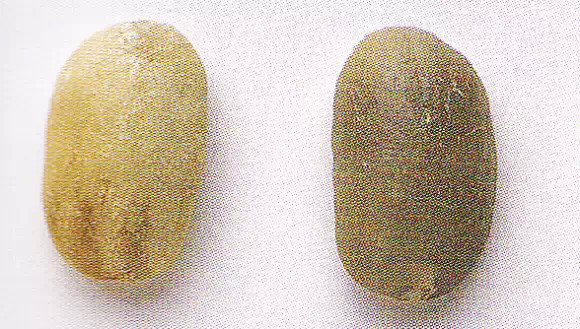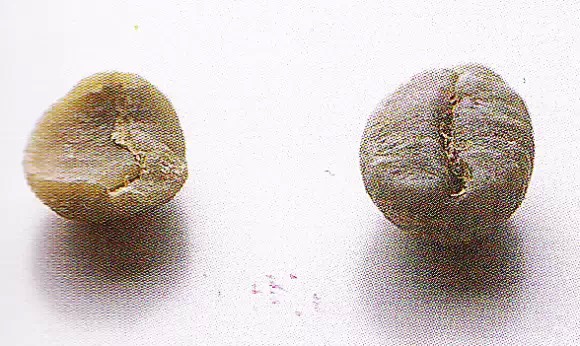Selection methods and matters needing attention of raw coffee beans
Raw beans before selection
The taste of fruit does not vary from size to size. What about coffee beans? What happens if coffee beans harvested from the same tree, regardless of grain size, ripe or immature, are all baked in the same pot?
When thick beans are baked with thin beans, the heat permeability of beans with thick beans is poor, and the center (the part of the bean that has not been removed) will be in a "cored" state that cannot be baked. When cooking spaghetti, it will be "cored" in order to have a moderate taste; but the "cored" state is only allowed to exist in the world of spaghetti, and the world of coffee does not work.
The appearance of the "cored" coffee can not be seen, only the beautiful surface of baked beans can be seen, but it is clear when cut open. The beans are divided into baked and unbaked parts. The coffee liquid extracted from the cored coffee will have a strong smell of choking throat.
To get back to the point, when choosing raw coffee beans, beans with uniform shape, thickness, size, color, central line and so on are all the best. In short, average beans are good beans. Unfortunately, such beans are extremely rare.
People often ask, what do you mean by G1 and G2, what do AA and AB mean, and why some G2 tastes better than G1? These are grading methods, and they are official ones, depending on size, defect rate and altitude. However, one thing that has not been noticed is that it is not graded according to taste. Coffee beans with large particles are highly valued in the same place of production according to their size. It is also said that the French taste of the sieve size (coffee bean size) has nothing to do with it. Now the Nordic countries, which are advanced coffee countries, purchase the most advanced coffee beans in Brazil and other places, mainly buying small pellet beans with a sieve size of 13-16. They avoid buying high-priced large granulated beans and buy cheap small ones instead, perhaps because they value quality over reputation.
But strictly speaking, large granulated coffee beans have a better flavor. In fact, the beans collected from the same coffee tree are baked and extracted, and the taste can be obviously compared after the cup test. Beans with large grains and smooth growth taste better.
When it comes to large-grained coffee beans, there are often high-quality beans like Marago Gippe (large granulated beans above sieve 19, also known as beans), which are twice as large as ordinary beans, which can cause uneven baking. therefore, it is recommended to pick out by hand in advance: but this is not to pick out defective beans, but to gather large grains of beans together and bake them separately.
When it comes to baking, rather than paying attention to the relationship between bean size and taste, the consistency of bean size is more important. Beans of different sizes should be separated from each other and should not be mixed and baked. Otherwise, it will inevitably lead to uneven baking results.
There is less water on the left and bluer on the right, which means more water.

Similarly, it is better to have the same color of beans. The colors of raw beans are cyan, brown and other colors, and the color of beans represents water content, so it is easier to bake beans with the same color. Generally speaking, cyan and green indicate more moisture, while brown almost white represents less moisture.
The beans on the left are thin and the beans on the right are thick.

Then there is the shape of the beans, and the meat should be thick. Even if the grains of beans are large, those with thin meat tend to taste thin. The flavor is rich and deep, generally speaking, only the fleshy coffee beans produced in the highlands. Kenya, Colombia, Tanzania and other Elaraby plus washable coffee beans are classified as "Colombian fresh and bright coffee" by the New York market; the meat is thick and the moisture content is high, so it is not easy to heat transfer in the center when roasting, but through excessive baking, it can lead to rich and varied flavor.
The last thing to mention is the central line (the longitudinal rill in the center of the coffee bean). Beans with a clear and clear central line are of high quality. In addition, the silver skin covered on its surface is literally silver. Most of the tea-brown ones with silver skin are defective, except for the well-managed natural drying beans.
What is hand-selected?
Hand selection: is the step of removing impurities and bad beans attached to delicious coffee beans. Coffee beans are often mixed with foreign bodies, such as stones, sawdust, pieces of metal, grains of soil, fruit of trees, and sometimes coins and glass.
In coffee production areas, specific gravity bean selector (using wind power to classify according to particle size and weight) or electronic bean selector (removing defective beans according to color) will be used to prevent impurities and defective beans from mixing, but it is only natural that they cannot be prevented. It still has to be chosen by human hands.
In particular, unripe beans are difficult to remove by machine and must be removed by hand. And these unripe beans will have a very bad effect on the taste of coffee. Defective beans in addition to unripe beans, there are dead beans, worm-eaten beans, black beans, moldy beans, shell beans, fermented beans, broken beans, shell beans, cocoa and so on.
Hand selection is carried out once in the raw bean stage, and again after baking, which means once before and after baking. The proportion of defective beans is surprisingly high, good coffee beans generally contain about 20%, and mocha with low precision system is more than 40%. That is to say, only about 60 to 70% of the coffee beans can be used after roasting. In other words, there will be 30 to 40 grams of failed beans in 100 grams of raw beans, which is quite wasteful. To reduce the roasting failure rate, you must buy high-precision and high-quality coffee beans as much as possible; if you are still afraid of roasting failure, the steps to remove defective beans should not be lazy. Defective beans are fatal to the taste of coffee.
When the ripe and red coffee fruit is picked by hand, the mixing rate of defective beans should be much lower, but in fact, it will be picked along with the cyan immature fruit during the harvest, and sometimes, even the branches will be broken off in pursuit of harvest efficiency. The water-washed coffee because the refining process must be washed many times, so it is more difficult to mix with stones, glass sheets and other impurities, but if the non-washing natural drying coffee, the degree of impurity mixing is quite high.
When roasting coffee mixed with too many defective beans, the finished coffee will be mottled in color. Compared with normal beans, defective beans oxidize very quickly, and some of them turn white after baking. Cheap coffee beans are often sold in stores such as supermarkets or coffee shops, and when you open those packages, you can find that there are quite a lot of unevenly roasted beans, all as a result of omitting the manual steps of direct baking.
The quickest way to understand the importance of hand-selected steps is to bake coffee liquid extracted with defective beans. After drinking it, you will find that your tongue will remain paralyzed for hours. It can be proved that hand selection is an indispensable and important step in making delicious coffee. I think it is a pity that people often regard hand selection as monotonous, boring and meaningless behavior. But I hope you understand that the taste damage caused by defective beans cannot be hidden no matter how clever the baking technique is. In order for the baking to proceed smoothly, it is important to select the steps by hand in advance.
Important Notice :
前街咖啡 FrontStreet Coffee has moved to new addredd:
FrontStreet Coffee Address: 315,Donghua East Road,GuangZhou
Tel:020 38364473
- Prev

The six steps of coffee tasting: aroma, aroma, taste, smell, aftertaste and mellowness
Coffee tasting has six steps to describe the aroma, aroma, taste, smell, aftertaste and mellowness of coffee. 1. Fragrance: the first step in tasting is to evaluate the aroma of coffee beans. Grind 8.25 grams of coffee, put it in 3-5 sample cups, and then breathe hard at the gas released by the freshly crushed coffee cells. The characteristics of the aroma indicate the taste of coffee beans.
- Next

How do I taste coffee? Coffee tasting also has some attention and knowledge
A cup of coffee is served in front of you. Don't drink it in a hurry. It should be like tea or wine tasting. There should be a gradual process to achieve the purpose of relaxation, refreshing and enjoyment. Overview You can add a little sugar and milk to your coffee, black, or European, adding cinnamon and other spices to your coffee, as in Africa and Arabia. If you are not used to the bitter taste of coffee, you can also
Related
- Detailed explanation of Jadeite planting Land in Panamanian Jadeite Manor introduction to the grading system of Jadeite competitive bidding, Red bid, Green bid and Rose Summer
- Story of Coffee planting in Brenka region of Costa Rica Stonehenge Manor anaerobic heavy honey treatment of flavor mouth
- What's on the barrel of Blue Mountain Coffee beans?
- Can American coffee also pull flowers? How to use hot American style to pull out a good-looking pattern?
- Can you make a cold extract with coffee beans? What is the right proportion for cold-extracted coffee formula?
- Indonesian PWN Gold Mandrine Coffee Origin Features Flavor How to Chong? Mandolin coffee is American.
- A brief introduction to the flavor characteristics of Brazilian yellow bourbon coffee beans
- What is the effect of different water quality on the flavor of cold-extracted coffee? What kind of water is best for brewing coffee?
- Why do you think of Rose Summer whenever you mention Panamanian coffee?
- Introduction to the characteristics of authentic blue mountain coffee bean producing areas? What is the CIB Coffee Authority in Jamaica?

